 |
|
NEW!
|
New! Dial in and
New Music for June 2022!
|
 |
Typical scenario where a Leslie motor has not been regularly maintained. The motor had not been disassembled and cleaned and lubricated for quite sometime. Dry bearings cause excessive wear, to the point where the armature becomes loose in the bearings. Thrust washers wear out causing excessive play from top to bottom of the motor and will cause the fan blades of the motor to strike the upper or lower bearing housings. This can also cause the motor to stall or simply not operate at all which unoticed will cause the motor to overheat and fail, The motor's cooling holes become clogged with dust, limiting the motor's ability to cool itself which in turn will burn the motor out prematurely. This can also become a fire hazard. Remember these Leslie motors are anywhere between 30 and 55 years old. They are all long beyond their prime.
|
 |
Another typical scenario. This motor was pulled from a Leslie model 47. The motor's vents are plugged with oil saturated dust. This will cause this 40+ year old motor to overheat and burn out from the lack of proper air circulation.
|
 |
This was first discovered in this same Leslie 47 when the upper cover was removed. The upper horn belt is broken from the continious friction of the frozen bearing in the idler pulley. These like the motors should be checked on a regular basis and oiled accordingly. This bearing is froze solid from the lack of lubrication and now the complete idler pulley and tension spring must be replaced.
|
 |
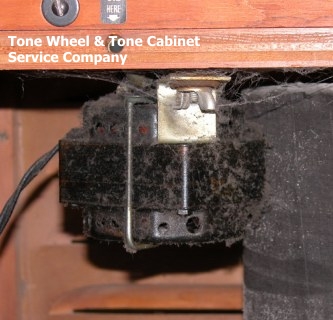 |
A view of the Leslie 22H motors (upper and lower) in the condition they were found. In this case these motors have been deprived of oil along with regular cleaning. A partitioner in this church believes the organ should be oiled 'once a month' where as the Leslie has not seen any oil in many years.
|
 |
 |
Above is a rim drive from a Leslie dual stack motor set. Shown is excessive wear to the O-ring, from the slow motor being too tight against the rim drive. As you can see this causes the O-ring to be cut into making the surface rough. Irregular wear can also cause low spots in the O-ring which can cause in consistent operation of the slow/choral/celeste operation of the Leslie motors.
|
 |
The Leslie horn and bearing plate. Dried oil and dust can cause sluggish response time of the horn tremolo along with a stretched belt will create excessive noise. Excessive oil propagates into the horn compression driver, along with dust which can cause contamination of the horn driver and ultimately damage. Remember these compression drivers have seen from 30 to 55 years of service.
|
 |
The Leslie Horn compression driver and bearing plate untouched. Notice the bearing plate seal in the middle of the throat. The seal has slipped and is covering nearly two thirds of the compression driver's throat. Also notice a combination of accumulated dust and oil which is deposited in the throat of the horn. The bearing plate originally had a bright metallic shine too it. This one is completely soaked and coated with excessive oil, dust, which is hardened to the surface. You can see the dust deposits which have also plugged up the opening in the front of the compression driver. This causes the horn driver's output to be restricted, which will cause the compression driver to overheat, which in turn causes the diaphragm to both physically and acoustically distort. The excessive heat will also cause the varnish applied to the voice coil to break down, which in turn will cause the voice coil to loosen and rub against the pole piece creating audible distortion and ultimately damaging it.
|
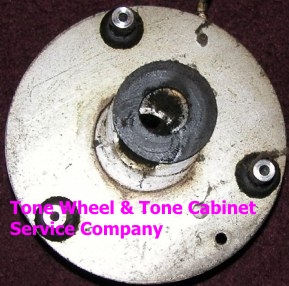 |
This is the back view of the bearing plate with the slipped compression driver seal in the same place before removal. Notice the excessive oil which is on and around the seal. This is from continued over oiling of the bearing of the Leslie horn.
|
 |
View of the Leslie compression driver's throat with the bearing plate removed. Notice the oil saturated dust which has partially clogged the output end of the driver. The surrounding dust on the face of the diaphragm's cover is also saturated with oil, as you can tell by the residual oil around the bearing plate's mounting holes in the diaphragm cover.
|
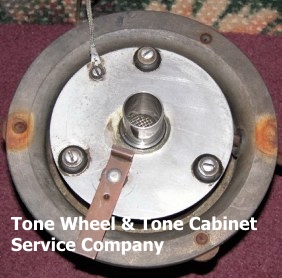 |
The complete horn compression driver unit after cleaning and reassembly, ready for a small amount of light white grease on the spindle plate bearing before it is reinstalled into the Leslie cabinet.
|
 |
Pictured is a V21 compression with similar problems from neglect. High accumulation of dust and oil which can propagate to the voice coil. The Grommets in this Leslie bearing plate have shrunk which allows the bearing plate to not be held tightly against the mouth of the compression driver. This allows sound to escape outside of the bearing plate causing reduced output. The bearing plate can move around from the centrifugal force of the Leslie horn (wobble) ultimately creating undesirable noise.
|
 |
An example of a Leslie 22H where as you can see the mechanics of this cabinet has not been cleaned or properly maintained in decades. A dry or gummed up horn bearing and clogged up Leslie motor vents will cause noise, lack of reliability and eventually failure.
|
 |
The Leslie 31h Series II Amplifier. Common problems, above the chassis are, failing power-supply capacitors, which create a drop in amplifier output, excessive hum, and taxes the power transformer and smoothing choke. Weak or shorted Vacuum tubes. Wafer tube sockets which have become extremely brittle from decades of heat break very easily. Socket pins break off one socket of one pair of the amp's 6L6's and rid that half of the amp non-operational. This can remain this way unnoticed without being checked on a regular maintenance schedule.
|

Common problems under the chassis of the Leslie 31h amp. Notice the broken octal socket pin in circled in yellow. The old wafer sockets become very brittle from heat over the decades and the pin seats become stretched from the pins of the tubes. The socket connectors are fragile from there age, and break off easily.
Old composition resistors which are common in all Leslie amps from the 31h style amp to the 122 and 147 up to the 1970s. Composition resistors can increase in value as much as double their marked value. The composition resistors are circled in purple. This will cause a drop power output and a decrease in the amps over all performance.
Cotton wiring which is marked in red in many cases is dipped in wax. This wiring is brittle, and falls apart when you try to work with it during any simple repair, and it is a serious fire hazard!
You will notice the Electrolytic capacitor which is circled in brown, you will notice leakage of the dielectric oil. This capacitor is on it's way to sure failure in the short term.
Lastly the coupling capacitors were replaced during a previous partial rebuild. They are circled in pink. These are a bit newer than the original wax capacitors, but they are around 30 years old and it is time that they be once again replaced when the amplifier has a complete rebuild.
|
 |
 |
Above is two examples of transformer lead wiring. This cotton coated wiring becomes extremely hardened and brittle. It is very difficult to manipulate reposition without risk of damage. This insulation can break away at any point between the inside of the transformer to the points under the chassis where it is connected. Note the melted and hardened wax drop from the insulation over one of the strands of wire. When an amplifier is either serviced or rebuilt the leads on all cloth insulated transformers are covered with color coded heat shrink tubing from the point where the windings are spliced to the leads inside the transformer to there stripped ends.
|
 |
 |
The Leslie 32h Series III Amplifier is the narrow chassis version of the 31a/h Leslie amplifier. An amplifier of this era suffers from the same types of problems and safety hazards as the Leslie 31h Amplifier. Brittle wafer vacuum tube sockets, wax dipped cotton wiring, wax encased/dipped capacitors which absorb huge amounts of moisture, become leaky and start to conduct. Aging/leaky electrolytic capacitors. You can see in the top photo where the main Electrolytic capacitor has been leaking on the amplifier chassis. Composition resistors which double in value from heat and age. Wire wound resistors which suffer from the same problem.
|

Common problems under the chassis of the Leslie 32h Series III amp. Notice the octal socket circled in yellow. These old wafer sockets become very brittle from heat over the many years of service. They become stretched from the pins of the tubes. The socket are fragile from there age, and break easily.
Old composition resistors which are common in all Leslie amps from the 31h style amp to the 122 and 147 up to the 1970s. Composition resistors can increase in value as much as double their marked value. The composition resistors are circled in purple along with the wire wound high wattage types. Increase in composition resistor's values cause a drop of power output the decrease in the amps over all performance.
Cotton wiring which is marked in red in many cases is dipped in wax. This wiring is brittle, and falls apart when you try to work with it during any simple repair, and it is a serious fire hazard!
The paper/wax capacitors are circled in pink. These components are at least 50 years old!!! As seen below a close up view of the damage done to these components and what the consequences will be.
|
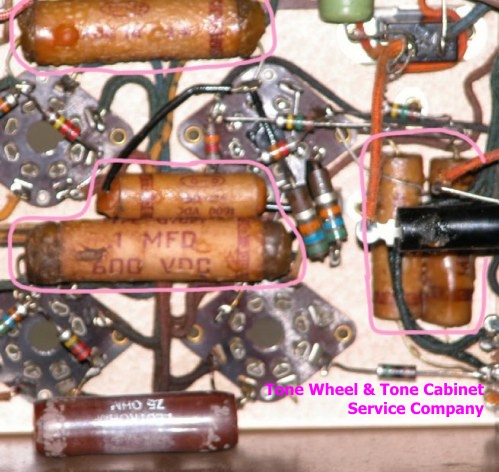
These coupling and bias capacitors circled in pink as you can see inside the Leslie 21h (32h Series III amplifier) have absorbed enough moisture that they have become leaky, and are shorting out which has caused them to heat up enough to melt the wax around and within the component. These components are now passing dc voltage which they were intended to block. A Leslie amplifier in this condition is a FIRE HAZARD just waiting happen!!!!
|
 |
Common problems above and below the chassis of the Leslie 22H amplifier.
Shown to the left is the main filter capacitor in the Leslie 22H amplifier. It is circled in pink. Over the years, this capacitor will dry out and or begin to become leaky and/or short out. Two of these things will cause decreased power of the amplifier, excessive distortion, and increased hum. If this filter capacitor starts to partially short out internally it will cause the rectifier diodes and or the power transformer to fail prematurely.
Dirty vacuum tube sockets which are marked in light blue become oxidized over time from heat and dirty which causes poor contact and will cause distortion as well as random popping and or thunder noises in the Leslie's loudspeakers. This can be remedied with a good cleaning. Tube sockets are also prone to stretching out over time and may also need replacing.
The input potentiometer, circled in orange and load switch can become dirty causing scratchiness intermittent operation and or the signal path being completely interrupted.
|

This amplifier has been partially rebuilt with the replacement of some capacitors. A few remain such as the single mica, two early mylar capacitors and two early Mallory film capacitors. The point here is the resistors marked in purple are also a very important part of the circuit and will cause the amplifier to not operate at it's full potential. Resistors can double in resistive value or higher with time and age. The high watt old style high wattage resistor in this type of amp which is circled in brown is extremely brittle from excessive heat and time. These will literally crumble when touched, therefore it should replaced at the time of a full rebuild. This Leslie amplifier also has an early Hammond Suzuki relay replacement board. The relay board is circled in yellow. The relay's in these boards are underrated and their contacts have a tendency to stick/weld closed. The punch down cinch connector as well as the pins of the plug become plagued with fractured solder joints over time. There are several choices. An original stock 22H relay can be installed, a RTC Logic solid state zero switching board can be installed, or amp can also be upgraded to the RTC Logic dual speed circuit which converts the single speed motors to dual speed operation of both Tremolo (Tremulant) and Choral (Celeste) mode as well as the stop mode with the addition of a three position Leslie moon switch and a diode circuit in the organ. Lastly you will notice the coil circled in blue. This is the choke for the brake circuit was used in the 22h and 47 style amplifiers. Typically the plastic cable clamp breaks and the coil hangs loose on it's wires. This can be a real problem if one of the side of the coil breaks and the coil shorts out against the Leslie amplifier's chassis.
|
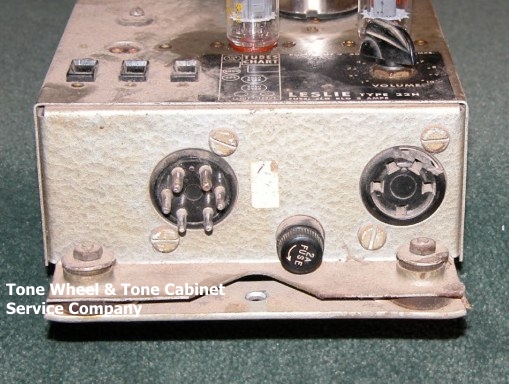 |
Notice the broken 5 pin chaining socket (to the right) on this Leslie 22H amplifier. This may not be a problem now but if the socket's rim breaks away any more the exposed metal parts can short out against the Leslie 22H's amplifier chassis. This will cause a short circuit, electrical shock hazard and/or potential fire hazard. The Leslie 22H's chaining socket is NOT protected by the amplifier's main fuse. It may not be evident but the male 6 pin plug of this amp has loose pins. This can be caused by several things. In the case of this Leslie the cabinet was pushed up against a wall too tightly and has put stress on the Leslie socket end of the cable as well as loosening the pins of the 6 pin Amphenol plug.
|
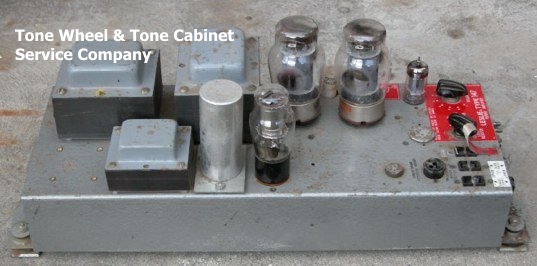 |
The Leslie 147 Amplifier. Common problems, above the chassis are, failing power-supply capacitors, which create a drop in amplifier output, excessive hum, and taxes the power transformer and smoothing choke. Weak or shorted Vacuum tubes. Micalex tube sockets which have become brittle over time from heat. The socket pins become stretched which will cause the vacuum tubes to not fit tightly creating intermittent operation, popping noises and even arcing. Without being checked regularly serious problems will develop.
|
 |
Common problems under the chassis of the Leslie 147 amplifier.
Old composition resistors which are common in all Leslie in the 147 amplifier along with the Leslie 122 up to the 1970s. Composition resistors can increase in value as much as double their marked value. The composition resistors are circled in purple. This will cause a drop power output and a decrease in the amps over all performance.
The Leslie 147 relay, circled in green can become intermittent do to a weak coil or badly pitted contacts. This can cause intermittent operation of the Leslie motors, popping in the loudspeakers from the relay's contacts arcing. We have affordable replacement solutions for this problem.
The rectifier diodes, circled in blue can fail from a short circuit in the amplifier, either caused by the electrolytic capacitor or shorted vacuum tubes.
The input potentiometer, circled in orange and load switch can become dirty causing scratchiness intermittent operation and or the signal path being completely interrupted.
Lastly the Mallory black capacitors are of early mylar composition. These components are circled in pink and are 30 years old or older.
|
 |
Shown to the left is the main filter capacitor in the Leslie 147 amplifier. It is circled in pink. Over the years, this capacitor will dry out and or begin to leak, or short out. Two of these things will cause decreased power of the amplifier, excessive distortion, and increased hum. If this filter capacitor starts to partially short out internally it will cause the rectifier diodes and or the power transformer to fail prematurely. A serious short will hopefully blow the main AC fuse, however damage to the afore mentioned components can occur before this safety device reacts to the excessive load.
|
 |
The 6550 power tube. Many of these old Tungsol, RCA, and GE originals are long beyond their prime. Weak vacuum tubes can cause loss of power distortion at low volumes. Internal shorts can cause arcing and will damage other high-voltage components in the amplifier such as the main filter capacitor and power transformer. I have seen instances where the vacuum tubes were arcing internally and the main power fuse NEVER opened the circuit. These along with other components in the Leslie speaker should be checked at regular intervals.
|